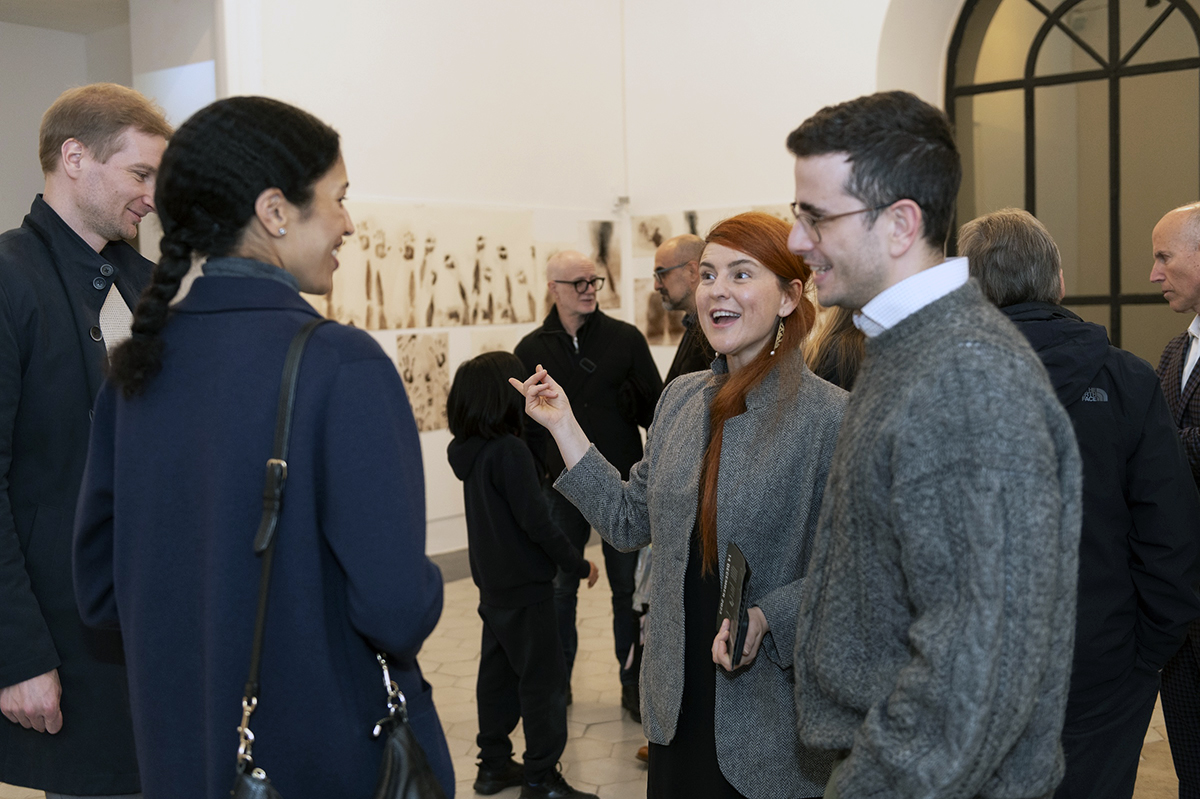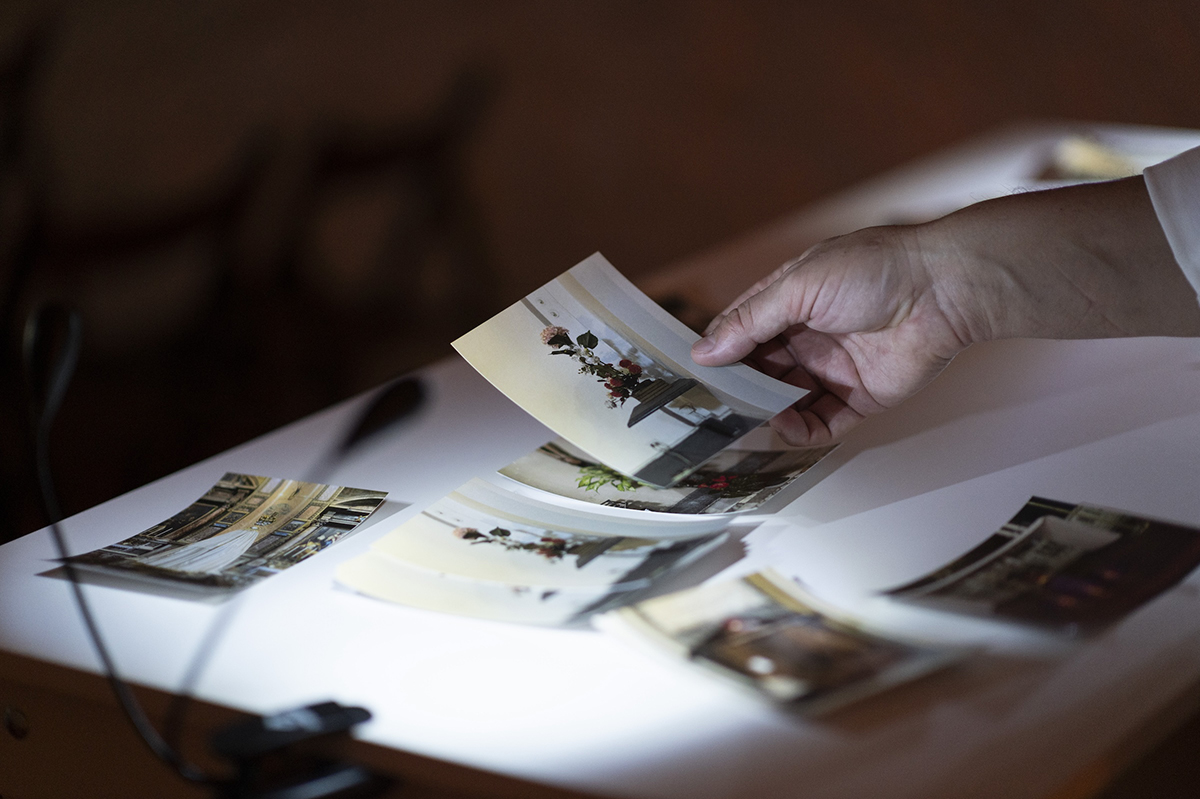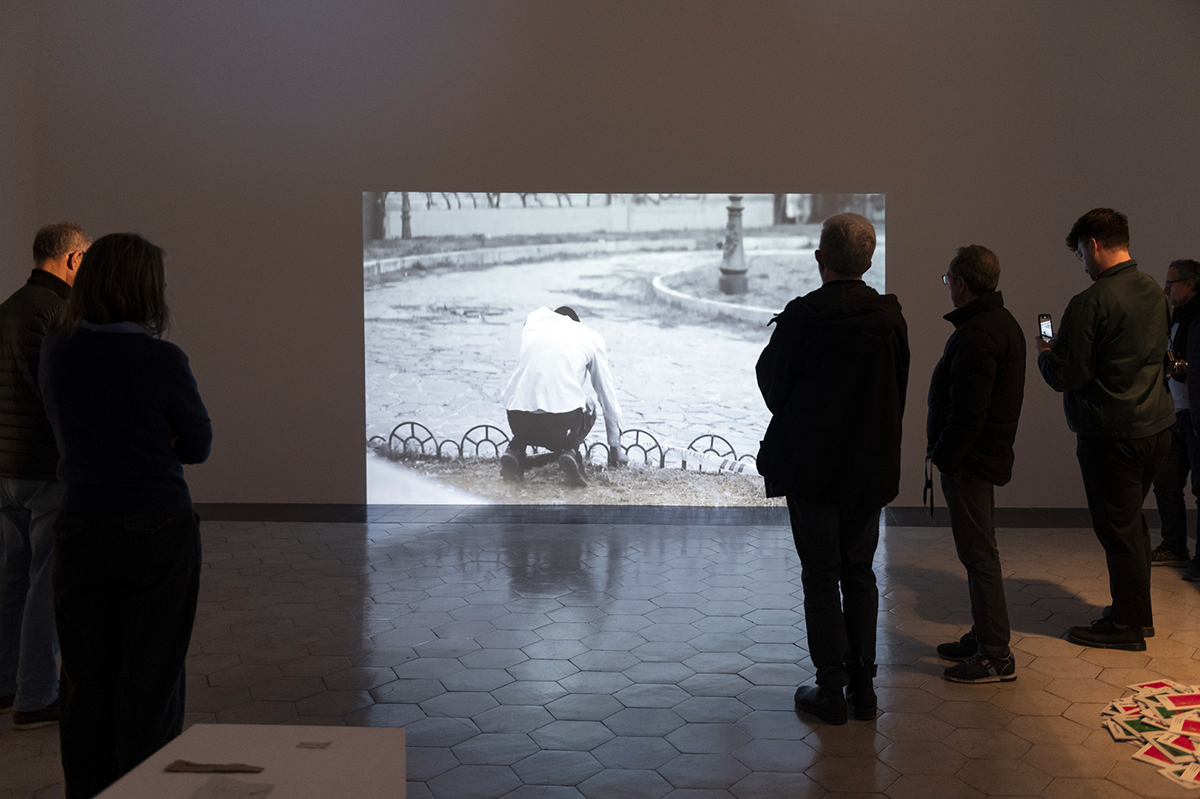Nearly five hundred visitors entered AAR’s gates for Winter Open Studios this past Thursday to see installations, artworks, films, textiles, music, and a publication by fall Fellows in the arts. Artists engaged with numerous themes including: public space in the city and spaces of worship; natural and handmade patterns; prototypes and functional objects; bodily prints and collective memory; violence and the vestiges and victims of war; operas and acoustics; and mutant organisms and life-altering diseases. These topics played out in and across the Academy’s campus, from the atrium to the gallery to the library.

Turin-based artist Fatma Bucak, the Fondazione Sviluppo e Crescita CRT Italian Fellow in Visual Arts, presented four works—a two-channel video work, a series of bronze sculptures, a screen print with typography, and a typographic print—about the environmental consequences of human actions in a political dimension. In her installation The Sum of the Misdeeds and Consents and Cowardly Acts, Bucak cast ten sculptures of birds native to Iraq in bronze in ascending size, a formal reference to measuring weights. Each bird is on the International Union for Conservation of Nature’s “red list” of threatened species, and the size of the sculpture corresponds to the degree of threat faced by each bird. The comparison to weights suggests ideas of control and value.
Elizabeth Whelan, the Cynthia Hazen Polsky and Leon Polsky Rome Prize Fellow in Design, presented new studies for her recent fabric innovation, Artemis. Visitors were encouraged to touch samples of the richly colored woven textiles, which feel springy, soft, and stretchy. The largest piece, colored deep blue with a wavy pattern of felt and silk, was crafted on a specialized industrial loom at MIT and flown to the Academy for the occasion. While in Rome, Whelan is examining silk woven velvet fabrics and artwork from the Renaissance, which was, she says, a time of exceptional innovation when artisans on the Italian peninsula created new patterns and weave structures that influenced textiles across Europe and even into North America.
Katie Kitamura, the Joseph Brodsky Rome Prize Fellow in Literature, collaborated with Stockholm-based artists Goldin+Senneby to produce a limited-run illustrated publication. Titled Turpentine / Flare-Up, the printed piece offered the opening chapters of each section of their collaborative project. Kitamura’s novel-in-progress comprises two discrete parts set in versions of the same world. The plot and characters in each story are shaped by different variables, including mutant organisms and life-altering diseases. The first half centers on a mysterious pine tree with a supercharged immune system; the second tells of a stranger whose sense of self—and biological coherence—comes into question as he seeks a novel treatment for his illness.

In the Cryptoporticus, Anthony Vine, the Rome Prize Fellow in Musical Composition, created the sound installation Visiting Hours, which explores the margins of Rome’s Catholic churches, using field recordings of church background music. The “wistful” recordings were accompanied by texts, moving images, and printed matter gathered from Vine’s visits to nearly one hundred churches in Rome.
Vine and Ajay Manthripragada (Rome Prize Fellow in Architecture) collaborated on an installation in the Arthur & Janet C. Ross Library. The work investigates the relations between space and sound. Developed from their interest in the materiality of clay and recording tape, the project is manifested in terracotta objects with ambiguous architectural forms. Referencing medieval ceramic resonators used to amplify singing, the sculpture shapes and excavates sounds from wheel-thrown clay objects and plays them back on magnetic tape, a pliant and versatile material that can be cut and assembled like clay. These sounds are amplified with the unfired vessels from which they came, creating a sonorous world that is mimetic and self-similar, yet always changing.

David Weeks, the Rolland Rome Prize Fellow in Design, exhibited drawings that attempt to capture the mass and permanence of Rome’s buildings while disclosing the city’s seemingly impossible infrastructure. The artist reveals the inner workings of the city through cutaway views of sidewalks showing the sewers and the imagined makeshift wooden structures that support them. In addition, Weeks debuted Scopo, a mobile chandelier that he prototyped in yellow paper using materials at hand. The chandelier-sculpture features a continuous threaded line that extends from the ceiling to the floor with a series of weighted lanterns in, as Weeks describes it, “a static line with a heartbeat.”
Dread Scott, the Abigail Cohen Rome Prize Fellow in Visual Arts, showed examples from a recent series of body prints, a technique that is well-integrated into his own artistic practice, but also one that was deployed extensively by 1990 Fellow David Hammons. To make the body prints, Scott coats parts of his body in oil and presses them against sheets of paper. Then he shakes powdered pigment over the oil that was transferred onto the paper. “The image I make is indexical—directly tied to my body,” Scott said. “In some of the prints, I paint into the image, augmenting what is revealed by the impression of my figure. Others are more expressive and respond to a world on fire with resting on mountains of oppression.”

Finally, Zachary Fabri, the Nancy B. Negley Rome Prize Fellow in Visual Arts, presented an installation about his experience making art at the Academy during the Palestine/Israel war. Stained wine glasses and used cappuccino cups were placed on the floor and on the ruins of the atrium. A letter stretched across a large canvas acted as a personal statement on empathy. Fabri also presented Grave Goods for the Common Man in Imperial Rome, which featured a photograph of the crate containing a skeleton that was found in AAR’s Bass Garden in 1999. The bronze pestle and mortar on top of the printed image contained the artist’s hair, and the black ankle boots held a branch from an olive tree in the Bass Garden. Both elements—natural and physical—have been cut and represented a peace offering for these times of war. Toward the end of the evening, Fabri performed in the Atrium and the Cortile, making his way within the crowd of guests, who were then invited to contribute to his installation. A work by Fabri about the Dogali Obelisk was also displayed in the AAR Gallery.
“This year’s edition of Winter Open Studios showcased the work in progress of the artists at AAR, and the Roman public engaged with all the works in different ways,” said Ilaria Puri Purini, AAR’s Andrew Heiskell Arts Dirrector. “It was wonderful!”
Winter Open Studios was made possible by the Adele Chatfield-Taylor Fund for the Arts. The program is also funded in part by grants from the Fromm Music Foundation and the Aaron Copland Fund for Music.